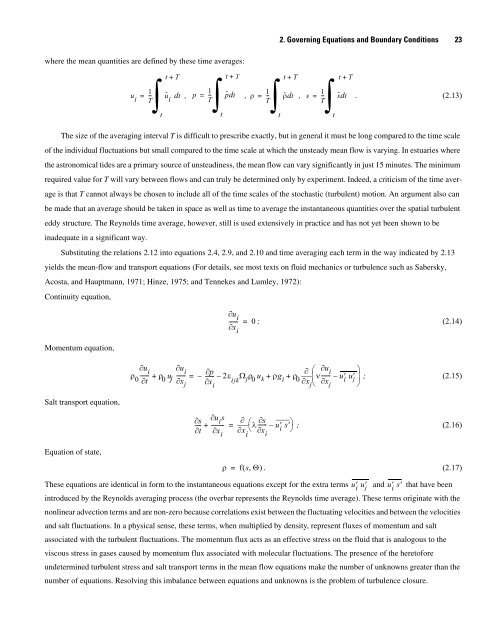A Semi-Implicit, Three-Dimensional Model for Estuarine ... - USGS
A Semi-Implicit, Three-Dimensional Model for Estuarine ... - USGS
A Semi-Implicit, Three-Dimensional Model for Estuarine ... - USGS
You also want an ePaper? Increase the reach of your titles
YUMPU automatically turns print PDFs into web optimized ePapers that Google loves.
where the mean quantities are defined by these time averages:<br />
2. Governing Equations and Boundary Conditions 23<br />
t+ T<br />
t + T<br />
t+ T<br />
t+ T<br />
u<br />
i<br />
= ∫ --<br />
1<br />
ũ<br />
T i<br />
t<br />
dt<br />
∫<br />
1<br />
, p = -- p˜ dt<br />
T<br />
t ∫<br />
1<br />
, ρ = -- ρ˜ dt<br />
T<br />
t ∫<br />
1<br />
, s = -- s˜ dt<br />
T<br />
t<br />
. (2.13)<br />
The size of the averaging interval T is difficult to prescribe exactly, but in general it must be long compared to the time scale<br />
of the individual fluctuations but small compared to the time scale at which the unsteady mean flow is varying. In estuaries where<br />
the astronomical tides are a primary source of unsteadiness, the mean flow can vary significantly in just 15 minutes. The minimum<br />
required value <strong>for</strong> T will vary between flows and can truly be determined only by experiment. Indeed, a criticism of the time aver-<br />
age is that T cannot always be chosen to include all of the time scales of the stochastic (turbulent) motion. An argument also can<br />
be made that an average should be taken in space as well as time to average the instantaneous quantities over the spatial turbulent<br />
eddy structure. The Reynolds time average, however, still is used extensively in practice and has not yet been shown to be<br />
inadequate in a significant way.<br />
Substituting the relations 2.12 into equations 2.4, 2.9, and 2.10 and time averaging each term in the way indicated by 2.13<br />
yields the mean-flow and transport equations (For details, see most texts on fluid mechanics or turbulence such as Sabersky,<br />
Acosta, and Hauptmann, 1971; Hinze, 1975; and Tennekes and Lumley, 1972):<br />
Continuity equation,<br />
Momentum equation,<br />
Salt transport equation,<br />
Equation of state,<br />
∂u<br />
i<br />
------ = 0 ; (2.14)<br />
∂x<br />
i<br />
∂u<br />
i<br />
∂u<br />
i<br />
ρ ------<br />
0<br />
ρ<br />
∂t<br />
0<br />
uj ------<br />
∂p<br />
∂ ⎛ ∂u<br />
i ⎞<br />
+ = – ------ – 2ε Ω<br />
∂xj<br />
∂x<br />
ijk jρ 0<br />
uk + ρg<br />
i<br />
+ ρ<br />
0 ⎜ν------ – u<br />
∂x<br />
i<br />
j ∂x<br />
i<br />
′ uj ′ ⎟ ; (2.15)<br />
⎝ j ⎠<br />
∂s<br />
∂u<br />
i<br />
s ∂ ∂s<br />
---- + --------- = ⎛λ------ – u<br />
∂t<br />
∂x<br />
∂x<br />
i i<br />
∂x<br />
i<br />
′ s′ ⎞ ; (2.16)<br />
⎝ ⎠<br />
i<br />
ρ = f( s, Θ)<br />
. (2.17)<br />
These equations are identical in <strong>for</strong>m to the instantaneous equations except <strong>for</strong> the extra terms u i ′ u j ′ and u i ′ s′ that have been<br />
introduced by the Reynolds averaging process (the overbar represents the Reynolds time average). These terms originate with the<br />
nonlinear advection terms and are non-zero because correlations exist between the fluctuating velocities and between the velocities<br />
and salt fluctuations. In a physical sense, these terms, when multiplied by density, represent fluxes of momentum and salt<br />
associated with the turbulent fluctuations. The momentum flux acts as an effective stress on the fluid that is analogous to the<br />
viscous stress in gases caused by momentum flux associated with molecular fluctuations. The presence of the hereto<strong>for</strong>e<br />
undetermined turbulent stress and salt transport terms in the mean flow equations make the number of unknowns greater than the<br />
number of equations. Resolving this imbalance between equations and unknowns is the problem of turbulence closure.

















